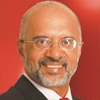A checkup on the health of global banks shows an industry in recovery but still threatened by rapidly changing externalities.

It’s a myth, although widely held, that the Chinese character for “crisis” contains the words “danger” and “opportunity”; but for global banks, it does seem that the financial crisis brought first danger, now opportunity. Ten years after the largest financial collapse in a generation, surviving banks have returned to health. The outlook for returns is rosier and expansion is on the table again. This appears to be especially true in the United States, and Europe has seen improvements too. The world’s financial institutions have weathered new regulatory demands and reputational hits, increased their capital and adopted new technologies.
“Economic growth is back and expectations are healthy,” says ING CEO Ralph Hamers. “Politically, there are uncertainties, with several elections coming up, and Brexit of course. Uncertainties are never good for business, so let’s hope things become clear soon.”
Yet recent history—as eventful as it has been—may be only a pale sample of what is to come. Experts are predicting a watershed moment for global banking and an upheaval sparked by even newer developments in technology, especially artificial intelligence, in combination with the political forces of regulation and demographic change.
“In the next five years, two things are going to determine how groups will sort themselves between who is going to grow and profit more and who is going to remain behind,” posits Gennaro Casale, partner and managing director at Boston Consulting Group in Milan. “The first is how well single institutions are able to manage—in a proactive, optimized and smart manner—all the regulations; the second is how well they are able to grasp the opportunities brought by digitization.”
New technologies will be front and center of the new successful bank, from payment systems to wealth management and lending for both corporate and retail customers. Mobile innovations, for example, offer huge potential for serving the planet’s vast numbers of unbanked.
Yet other factors will also have significant impact. Plagued by reputational issues in Europe and in the US, banks increasingly face political challenges and a struggle to recruit the best and brightest. Fresh graduates are often more interested in working for tech companies or consultants than for the traditional financial industry. A career at a large Wall Street bank has lost most of its allure. Graduates from top business schools such as MIT often prefer industries that are less plagued by bad image and potential for crisis. The list of top nine employers for the MIT 2016 class includes only one bank: Bank of America Merrill Lynch. At number eight, it is topped by McKinsey, Amazon, Bain & Co. and Boston Consulting Group. Some banks have improved conditions for new entrants, increasing pay or bonuses or length of potential leaves. Technological innovation may have more impact, by making the industry feel more dynamic and youthful.
“Banks have a hard time now being sexy employers,” says BCG’s Casale. “It is a bit harder to understand how to get out of this.”
At the same time, demographic change is transforming the customer base as well. Here, too, technology holds promise for addressing new desires and habits.
THE NEW NEW THING
Along with mobile technology, artificial intelligence (AI) is the next great hope. AI offers banks the two-fold promise of cutting costs while improving the customer experience. Still, the concomitant privacy and security concerns ensure these opportunities will be circumscribed by regulators, leaving the ultimate benefits a big open question.
So far, the introduction of online banking has often broken the traditional customer-teller relationship by taking customers out of the physical branches; AI can revive a more personalized banking experience. Already, through interactions with AI in the recommendations of Amazon or Netflix, consumers are warming to advice from robot brains. “Customers are becoming used to the idea of artificial intelligence being helpful and making them recommendations—customizing the offers that they get and essentially providing in-the-moment advice on how to transact and how to select products,” says Alan McIntyre, senior managing director of global banking at Accenture. “We are definitely seeing a move toward that, where customers are more and more willing to accept robotic advice in banking.”
The shift from humans to robots can also represent for banks a fresh shot at redemption after a series of frauds and scandals around the world: fake accounts at Wells Fargo in the US, for example, or Libor rigging by Barclay’s in Europe, or BSI’s failings in Asia, or currency manipulations in Africa and elsewhere.
“Customers have to trust the bank is acting in their best interest; and clearly the banking industry has had issues in multiple geographies, in both the US and the UK, for selling inappropriate products. If the robotic advice is going to get real traction it is going to have to be unbiased, it is going to have to demonstrate that it is good for customers,” says McIntyre. “In general, what we see is that customers trust the robotic advice more than advice from individuals. They see the robotic device as more likely to be unbiased.”
CLIENTS ON THE GO
Even when the advice doesn’t come from a robot, digital technology improves access. In Brazil, for example, Santander has deployed digital management to serve more than 200,000 SME and wealthy customers with remote, but still human, advisors—a model the bank is exporting to all its main geographies, according to Javier Castrillo, head of business intelligence.
Digital tech’s biggest boost has been in reaching new customers; the advantages of mobile in reaching Africa’s unbanked are well documented, for example. In Asia, too, the middle class has grown more rapidly than bank branch networks. “Not having a physical infrastructure of branches that has developed with time, like in Western countries, they need ways of serving a pool of clients that is fast growing,” says BCG’s Casale. “So they are a bit forced to accelerate this digital jump.”
 |
 |
 |
 |
Singapore’s DBS, for example, described by industry observers as a technological leader, has just 12 branches in India now, according to CEO Piyush Gupta. And if it gains approval for status as a wholly owned subsidiary, it plans to add 50–75 branches over five years. In the meantime, however, it introduced digibank, India’s first mobile-only bank, and scooped up 840,000 customers in 10 months without the need for a brick-and-mortar network. Plans are underway to introduce digibank in other markets, starting with Indonesia, and continue to grow organically. “We believe that the large transformational acquisition is yesterday’s battle,” he adds. “We’d rather focus on digital, which is tomorrow’s war.”
That “war” is at least in part between banks and tech firms, who are becoming the best of “frenemies”—with collaboration and competition in equal measure. Twenty or more large US banks should soon launch Zelle, a peer-to-peer payment application that will compete with Venmo, the payment app owned by PayPal and originally launched as an alternative to person-to-person mobile payments. “Banks are absolutely looking to innovation and ideas that come out of fintechs,” says Jeremy Anderson, chairman of Global Financial Services at KPMG. “Those banks that can be flexible and agile and are successful in transforming their core processes with these new emergent technologies will be the winners of the future.”
The tension between banks and fintechs, at times uncomfortable, can spur innovation. “Fintechs will push banks to become much more innovative; and as banks are forced to innovate, some will do it internally and some will work together with fintechs as partners,” says Pieter van den Berg, partner and managing director at Boston Consulting Group in New York. “Innovation will go much faster than it did in the past, and it will also become more of an ecosystem. Banks will need to learn how to work with fintechs and other parties in the ecosystem to innovate, rather than being focused on just the internal IT of the organization.”
TECHNOLOGY FOR SECURITY
The banks are finding technology a boon not just for boosting efficiency and reaching new markets, but also for enhancing security, to both protect clients and meet legal requirements. Santander, for example, is already tapping biometrics to support its anticrime Know Your Customer efforts, according to Castrillo, with more than 30% of active customers in Mexico currently using it, as well as millions of customers in Brazil. “Expected increases in regulatory pressure will be a challenge for financial institutions in the coming years,” says Castrillo. “We are in permanent contact with central banks and regulatory institutions to anticipate any significant changes and adapt our practices accordingly.”
Regulatory management is a key component of Anaplan, for example, a Cloud-based connected-planning platform that companies can use to make faster and more-informed decisions. “The implementation of the CCAR regulation in the US or CRD-IV in Europe led the banks to significantly upgrade their risk, regulatory and finance architectures. However, these in many cases were developed in isolation, translating into manually intensive reconciliation processes between finance, risk and regulatory data,” explains Henri Wajsblat, head of Anaplan’s Financial Services Solutions. “Being able to streamline this data and align finance and regulatory forecasts in a single-version-of-the-truth platform is high priority.”
Indeed, Anaplan showcases the range of issues impacting bank decisions. For instance, a bank may want to assess the options of relocating its business while exiting the UK because of Brexit. With Anaplan, “the bank can easily see the impact on its key performance indicators of reducing headcount or moving staff to a place such as Luxembourg, Paris or Frankfurt—or even to split resources across multiple jurisdictions,” Wajsblat explains. “Our solution considers all the dimensions, including the impact of regulation, macroeconomic environment, tax implications or local business outlook.” When he joined the company two years ago, Wajsblat says, it had almost no bank or finance clients. Now it has won dozens of international financial institutions to its platform, including HSBC, Morgan Stanley and Barclaycard.



